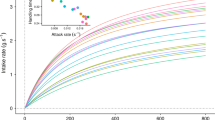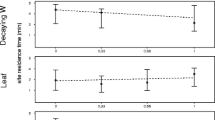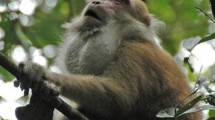Abstract
In fulfilling their daily activities, animals must expend the least amount of energy possible while feeding in order to optimise their energy balance. Food is removed by congeners as a result of exploitation competition. When a resource becomes limited, an increase in the probability of interference competition (direct competition for the resource) is triggered. While a high social rank may increase foraging time and resource access, this status also has detrimental facets. To explore the benefits of dominance/aggression in a context where true monopolisation of resources could be advantageous, we tested three hypotheses related to the patchiness of resources, agonistic activity (i.e. dominance and aggression) and individual attributes (i.e. morphology and behaviour) in a group of captive mouflon males (Ovis ammon musimon). Feeding performance was analysed using linear mixed models based on predictors about patchiness of the resource, and behavioural and morphological indices. No clear relationship was found between dominance and feeding performance. However, the general pattern showed (i) a decrease in overall feeding performance with the dispersion of the resource; (ii) that the discrepancy in feeding performance among individuals was maximal when confronted with intermediate conditions; and (iii) that alternative tactics allowed subordinate individuals to achieve a similar feeding performance to dominants. The results of this study suggest that, over and above agonistic behaviour and dominance, the motivation of individuals and its variation over time, though difficult to evaluate, could be key to understanding the coexistence of alternative behavioural tactics.


Similar content being viewed by others
References
Appleby MC (1980) Social rank and food access in red deer stags. Behaviour 74:294–309
Arnold GW, Maller RA (1974) Some aspects of competition between sheep for supplementary feed. Anim Prod 19:309–319
Baayen RH, Davidson DJ, Bates DM (2008) Mixed-effects modeling with crossed random effects for subjects and items. J Mem Lang 59:390–412
Barrette C, Vandal D (1986) Social rank, dominance, antler size, and access to food in snow-bound wild woodland caribou. Behaviour 97:118–146
Barroso FG, Alados CL, Boza J (2000) Social hierarchy in the domestic goat, effect on food habits and production. Appl Anim Behav Sci 69:35–53
Barton K (2012) Package ‘MuMIn’: model selection and model average based on information criteria (AICc and alike). CRAN R Project. Available from http://cran.r-project.org/web/packages/ MuMIn/MuMIn.pdf (accessed April 2015)
Bates D (2005) Fitting linear mixed models in R. R news 5:27–30
Bates D, Maechler M, Bolker B (2012). lme4: Linear mixed-effects models using S4 classes. R package version 0.999999-0. http://CRAN.R-project.org/package=lme4
Bergvall UA, Schäpers A, Kjellander P, Weiss A (2010) Personality and foraging decisions in fallow deer, Dama dama. Anim Behav 81:101–112
Biro PA, Stamps JA (2015) Using repeatability to study physiological and behavioural traits: ignore time-related change at your peril. Anim Behav 105:223–230
Bolker BM, Brooks ME, Clark CJ, Geange SW, Poulsen JR, Stevens MHH, White JSS (2009) Generalized linear mixed models: a practical guide for ecology and evolution. Trends Ecol Evol 24:127–135
Bonenfant C, Pelletier F, Garel M, Bergeron P (2009) Age-dependent relationship between horn growth and survival in wild sheep. J Anim Ecol 78:161–171
Bouissou MF (1995) Social relationships, aggressive behaviour and emotional reactivity in ungulates, influences of sex steroids. Prod Anim 8:71–82
Bouissou MF, Gaudioso (1982) Effect of early androgen treatment on subsequent social behaviour in heifers. Horm Behav 16:132–146
Brouns F, Edwards SA (1994) Social rank and feeding behaviour of group-housed sows fed competitively or ad libitum. Appl Anim Behav Sci 39:225–235
Brown JL (1964) The evolution of diversity in avian territorial systems. Wilson Bull 76:160–169
Buckland ST, Burnham KP, Augustin NH (1997) Model selection: an integral part of inference. Biometrics 53:603–618
Burnham KP, Anderson DR (2010) Model selection and multi-model inference: a practical information-theoretic approach. Springer, New York
Carranza J, Garcia-Muñoz AJ, deDios Vargas J (1995) Experimental shifting from harem defence to territoriality in rutting red deer. Anim Behav 49:551–554
Ceacero F, García AJ, Landete-Castillejos T, Bartosova J, Bartos L, Gallego L (2012) Benefits for dominant red deer hinds under a competitive feeding system, food access behaviour, diet and nutrient selection. PLoS One 7, e32780. doi:10.1371/journal.pone.0032780
Chase ID, Tovey C, Spangler-Martin D, Manfredonia M (2002) Individual differences versus social dynamics in the formation of animal dominance hierarchies. PNAS 99:744–749
Côté SD (2000) Determining social rank in ungulates, a comparison of aggressive interactions recorded at a bait site and under natural conditions. Ethology 106:945–955
Craig JV (1986) Measuring social behavior. J Anim Sci 62:1120–1129
Csermely D, Wood‐Gush DG (1990) Agonistic behaviour in grouped sows II How social rank affects feeding and drinking behaviour. Italian J Zool 57:55–58
De Young RW, Demarais S, Honeycutt RL, Gee KL, Gonzales RA (2006) Social dominance and male breeding success in captive white-tailed deer. Wildl Soc Bull 34:31–136
Dennehy JJ (2001) Influence of social dominance on habitat selection by free-ranging ungulates. Behav Ecol 12:177–181
R Development Core Team (2013) R: a language and environment for statistical computing. R Foundation for Statistical Computing. http://www R-project org
Drews C (1993) The concept and definition of dominance in animal behaviour. Behaviour 125:283–313
Dunbar RIM, Dunbar E (1981) The grouping behaviour of male Walia ibex with special reference to the rut. Afr J Ecol 19:251–263
Enoksson B (1988) Age- and sex-related differences in dominance and foraging behaviour of nuthatches Sitta europae. Anim Behav 36:231–238
Epsmark Y (1974) Social behaviour of roe deer at winter feeding stations. Appl Anim Ethol 1:35–47
Erhard HW, Fàbrega E, Stanworth G, Elston DA (2004) Assessing dominance in sheep in a competitive situation: level of motivation and test duration. Appl Anim Behav Sci 85:277–292
Festa-Bianchet M (1991) The social system of bighorn sheep: grouping patterns, kinship, and female dominance rank. Anim Behav 42:71–82
Fournier F, Festa-Bianchet M (1995) Social dominance and conflict reduction in rutting male Alpine ibex, Capra ibex. Anim Behav 49:1449–1459
Gabor CR, Jaeger R (1995) Resource quality affects the agonistic behaviour of territorial salamanders. Anim Behav 49:71–79
Gill ID, Helfield JM (2012) Alternative foraging strategies among bears fishing for salmon: a test of the dominance hypothesis. Can J Zool 90:766–775
Granados JE, Perez JM, Soriguer RC, Fandos P, Ruiz-Martinez I (1997) On the biometry of the Spanish ibex, Capra pyrenaica, from Sierra Nevada (Southern Spain). Folia Zool 46:9–14
Grant JWA, Guha R (1993) Spatial clumping of food and social dominance affect interference competition among ruddy turnstones. Behav Ecol 4:293–296
Grueber CE, Nakagawa S, Laws RJ, Jamieson IG (2011) Multimodel inference in ecology and evolution: challenges and solutions. J Evol Biol 24:699–711
Guilhem C, Bideau E, Gerard JF, Maublanc ML (2000) Agonistic and proximity patterns in enclosed mouflon (Ovis gmelini) ewes in relation to age, reproductive status and kinship. Behav Process 50:101–112
Gyimesi A, Stillman RA, Nolet BA (2010) Cryptic interference competition in swans foraging on cryptic prey. Anim Behav 80:791–797
Hansen BB, Aanes R, Herfindal I, Sæther BE, Henrikse (2009) Winter habitat-space use in a large arctic herbivore facing contrasting forage abundance. Polar Biol 32:971–984
Hass CC, Jenni DA (1991) Structure and ontogeny of dominance relationships among bighorn rams. Can J Zool 69:471–476
Hirata M, Nakayama Y, Tobisa M (2010) Interindividual variability in feeding station behavior in cattle: a preliminary study. Grassl Sci 56:108–115
Hollis KL, Langworthy-Lam KS, Blouin LA, Romano MC (2004) Novel strategies of subordinate fish competing for food, learning when to fold. Anim Behav 68:1155–1164
Jørgensen GHM, Andersen IL, Bøe KE (2007) Feed intake and social interactions in dairy goats—the effects of feeding space and type of roughage. Appl Anim Behav Sci 107:239–251
Kiley-Worthington M (1978) The social organization of a small captive group of eland, oryx and roan antelope with an analysis of personality profiles. Behaviour 66:32–55
Krueger K, Flauger B (2008) Social feeding decisions in horses (Equus caballus). Behav Process 78:76–83
Kurvers RHJM, van Sarten de Hoog SI, van Wieren SE, Ydenberg RC, Prins HH (2011) No evidence for negative frequency-dependent feeding performance in relation to personality. Behav Ecol 23:51–57
Leblond M, Dussault S, Ouellet J-P (2010) What drives fine-scale movements of large herbivores? A case study using moose. Ecography 33:1102–1112
Lemel J, Wallin K (1993) Status signalling motivational condition and dominance, an experimental study in the great tit, Parus major. Anim Behav 34:549–558
Maisels FG (1993) Seasonal variation in grouping patterns of the forest-dwelling Cyprus mouflon Ovis orientalis. J Zool 229:527–532
Martin P, Bateson P (1986) Measuring behaviour, an introductory guide. Cambridge university press, Cambridge
Masteller MA, Bailey J (1988) Agonistic behavior among mountain goats foraging in winter. Can J Zool 66:2585–2588
Michelena P, Sibbald AM, Erhard HW, McLeod JE (2009) Effects of artificial food on the winter activity of White-tailed Deer Odocoileus virginianus living in the north of the area of their distribution. Behav Ecol 20:145–152
Miranda-de la Lama GC, Sepúlveda WS, Montaldo HH, María GA, Galindo F (2011) Social strategies associated with identity profiles in dairy goats. Appl Anim Behav Sci 134:48–55
Neumann C, Duboscq J, Dubuc C, Ginting A, Irwan AM, Agil M, Widdig A, Engelhardt A (2011) Assessing dominance hierarchies: validation and advantages of progressive evaluation with Elo-rating. Anim Behav 82:911–921
Pinheiro JC, Bates D (2000) Mixed-effects Models in S and S-plus. Springer-Verlag, New York, NY
Prins HHT (1989) Buffalo herd structure and its repercussions for condition of individual African buffalo cows. Ethology 81:47–71
Richards SA, Whittingham MJ, Stephens PA (2011) Model selection and model averaging in behavioural ecology: the utility of the IT-AIC framework. Behav Ecol Sociobiol 65:77–89
Roden C, Vervaecke H, Van Elsacker L (2005) Dominance, age and weight in American bison males (Bison bison) during non-rut in semi-natural conditions. Appl Anim Behav Sci 92:169–177
Rowell TE (1966) Hierarchy in the organization of a captive baboon group. Anim Behav 14:430–433
Rowell TE (1974) The concept of social dominance. Behav Biol 11:131–154
Rowell TE, Rowell CA (1993) The social organization of feral Ovis aries ram groups in the pre-rut period. Ethology 95:213–232
Rubenstein DI (1994) The ecology of female social behavior in horses, zebras, and asses. In: Jarman P, Rossiter A (eds) Animal Societies: Individuals, Interactions, and Organization. Kyoto University Press, Kyoto, pp 13–28
Rutberg AT (1986) Dominance and its fitness consequences in American bison cows. Behaviour 96:62–91
Ryer CH, Olla B (1996) Social behavior of juvenile chum salmon, Oncorhynchus keta, under risk of predation, the influence of food distribution. Environ Biol Fishes 45:75–83
Santiago-Moreno J, Gómez-Brunet A, Toledano-Díaz A, González-Bulnes A, Picazo RA, Lopez-Sebastian A (2005) Influence of age on the relationship between annual changes in horn growth rate and prolactin secretion in the European mouflon (Ovis gmelini musimon). Anim Reprod Sci 85:251–261
Schaller GB (1977) Mountain Monarchs, Wild sheep and goats of the Himalaya. The Univ, Chicago Press, Chicago
Scheipl F (2010) Rlrsim: Exact (Restricted) Likelihood Ratio Tests for Mixed and Additive Models. R package, version 2.0e5. published online 9 January 2007
Schmidt KT, Hoi H (1999) Feeding tactics of low-ranking red deer stags at supplementary feeding sites. Ethology 105:349–360
Schmidt KT, Seivwright LJ, Hoi H, Staines BW (1998) The effect of depletion and predictability of distinct food patches on the timing of aggression in red deer stags. Ecography 21:415–422
Searle KR, Hunt LP, Gordon IJ (2009) Individualistic herds, individual variation in herbivore foraging behavior and application to rangeland management. Appl Anim Behav Sci 122:1–12
Senar JC (1990) Agonistic communication in social species: What is communicated? Behaviour 112:270–283
Sherwin CM (1990) Priority of access to limited feed, butting hierarchy and movement order in a large group of sheep. Appl Anim Behav Sci 25:9–24
Shi J, Dunbar RIM (2006) Feeding competition within a feral goat population on the Isle of Rum, NW Scotland. J Ethol 24:117–124
Shrader AM, Kerley GI, Kotler BP, Brown JS (2007) Social information, social feeding, and competition in group-living goats (Capra hircus). Behav Ecol 18:103–107
Smallegange IM, van der Meer J, Kurvers RHJM (2006) Disentangling interference competition from exploitative competition in a crabbivalve system using a novel experimental approach. Oikos 113:157–167
Stanley CR, Dunbar RIM (2013) Consistent social structure and optimal clique size revealed by social network analysis of feral goats, Capra hircus. Anim Behav 85:771–779
Stears K, Kerley GI, Shrader AM (2014) Group-living herbivores weigh up food availability and dominance status when making patch-joining decisions. PLoS One 9(10):e109011
Sundström LF (2001) Experience and social environment influence the ability of young brown trout to forage on live novel prey. Anim Behav 61:249–255
Taillon J, Côté SD (2007) Social rank and winter forage quality affect aggressiveness in white-tailed deer fawns. Anim Behav 74:265–275
Thompson AK, Samuel MD, DEELEN TR (2008) Alternative feeding strategies and potential disease transmission in Wisconsin white‐tailed deer. J Wildl Manag 72:416–421
Thouless CR (1990) Feeding competition between grazing red deer hinds. Anim Behav 40:105–111
Vahl WK, Lok T, Meer J, van der Piersma T, Weissing F (2005) Spatial clumping of food increases its monopolisation and defence by convict cichlids, Cichlasoma nigrofasciatum. Behav Ecol 16:834–844
Veiberg V, Loe LE, Mysterud A, Langvatn R, Stenseth N (2004) Social rank, feeding and winter weight loss in red deer, any evidence of interference competition? Oecologia 138:135–142
Vestal BM, Stoep A (1978) Effect of distance between feeders on aggression in captive chamois (Rupicapra rupicapra). Appl Anim Ethol 4:253–260
Villaret J-C, Bon R (1998) Sociality and relationships in Alpine ibex (Capra ibex). Rev Ecol (Terre Vie) 53:153–170
von Hardenberg A, Bassano P, Peracino A, Lovari S (2000) Male alpine chamois occupy territories at hotspots before the mating season. Ethology 106:617–630
Wierenga HK (1990) Social dominance in dairy cattle and the influences of housing and management. Appl Anim Behav Sci 27:201–229
Acknowledgments
The authors would like to thank the technical staff of the CEFS laboratory, especially J.-M. Angibault, N. Cèbe and L. Desneux, for their support in the field. Some anonymous referees made helpful comments on a previous version of the manuscript. E. Serrano was supported by the postdoctoral program (SFRH/BPD/96637/2013) of the Fundação para a Ciência ea Tecnologia, Portugal. We are grateful to Mark Hewison for his valuable revision and suggestions and to Peter Winterton and Sarah Young for polishing up the English text.
Author information
Authors and Affiliations
Corresponding author
Rights and permissions
About this article
Cite this article
Kidjo, N., Serrano, E., Bideau, E. et al. Is dominance the only factor determining access to food in an agonistic context? An experiment with captive male mouflon. acta ethol 19, 69–79 (2016). https://doi.org/10.1007/s10211-015-0226-8
Received:
Revised:
Accepted:
Published:
Issue Date:
DOI: https://doi.org/10.1007/s10211-015-0226-8




